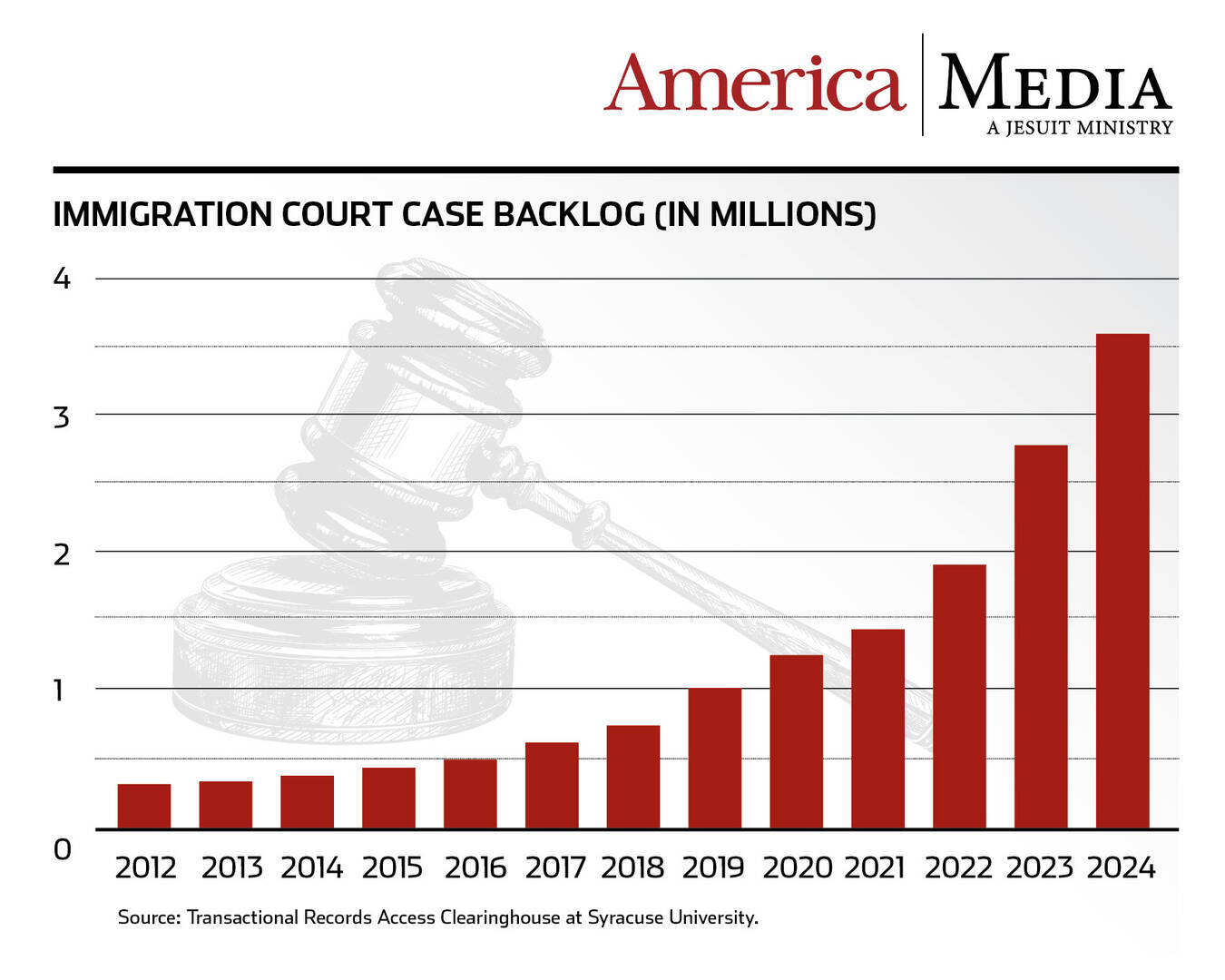According to Texas Attorney General Ken Paxton, his office has obtained sworn testimony that Annunciation House—a Catholic outreach serving migrants in El Paso, Tex.—facilitates illegal border crossing and conceals “illegally present aliens from law enforcement.”
“Any [nongovernmental organization] facilitating the unlawful entry of illegal aliens into Texas is undermining the rule of law and potentially jeopardizing the safety and wellbeing of our citizens,” Mr. Paxton said in a statement last week. “All NGOs who are complicit in Joe Biden’s illegal immigration catastrophe and think they are above the law should consider themselves on notice.”
It is tough talk—but not new. The notion that the humanitarian organizations have caused, to some extent, the influx of migrants at the southern border has become a common narrative in the last few years. The Heritage Foundation, for example, published a column in 2023 speculating that “it’s not unreasonable to allege that the [Biden] administration is paying NGOs to smuggle illegal aliens the final miles of their journey.”
In 2021, Todd Bensman of the Center for Immigration Policy offered similar ruminations in The Federalist. He wrote that “U.S. taxpayer money is being spent in contravention of American immigration law and national interest in controlling the border against economic migration.”
These considerations often use facts as their points of departure. The U.S. government does financially support humanitarian outreach to migrants and asylum seekers, both on the U.S.-Mexico border and throughout Latin America. But do the conclusions follow? Does this humanitarian aid lead to the thousands of migrants and asylum seekers searching for entry at the southern border? Or, to put it another way: Will cutting humanitarian assistance help the crisis? America asked immigration experts to weigh in.
Shelter in a foreign land
Casa Alitas, a temporary shelter for asylum seekers, opened its doors in 2013 as a five-bedroom house. The shelter, run by Catholic Community Services of Southern Arizona, has moved locations numerous times to accommodate the escalating number of migrants.
Earlier this year, Tom Tiffany—a Republican House Representative from Wisconsin—showed up to the shelter unannounced. He was denied entry. Mr. Tiffany was inspired to visit after seeing a video posted on X by James O’Keefe, the founder of Project Veritas who was forced out of the conservative activist group last year, which speculated that the site was complicit in human trafficking.
“It concerns me that we’re not even starting off with a factually based question,” Diego López, the director of Casa Alitas, told America. Both Mr. O’Keefe and Mr. Tiffany falsely claimed Casa Alitas was helping “illegal immigrants.” In fact, those who arrive at the shelter are asylum seekers and have therefore been processed by U.S. Customs and Border Protection.
“The roles that N.G.O.s are playing are roles that we wish our federal government was fulfilling,” Luis Guerra, a legal advocate with the Catholic Legal Immigration Network, told America. “But in the absence of either federal resources or state or local resources, N.G.O.s have filled a void.”
“But the biggest myth to debunk is that there’s some sort of operation where folks are being passed on by smugglers to N.G.O.s, and then N.G.O.s are facilitating that smuggling across the borders,” Mr. Guerra said. “That’s just false.”
Asylum is an ongoing concern, he said, noting the backlog of cases, each of which can take years to process.
“You can’t access the port of entry and ask for asylum,” Mr. Guerra said. “If you’re fleeing from danger, your only recourse is to go around the gate to ask for asylum because you know you’re going to get processed. If you go to a port of entry, you will be turned away. You can’t actually access asylum through the door.”
The large majority of people seeking asylum have a legitimate fear of returning to their home country, Mr. Guerra said. The challenge is articulating their case in such a way that grants access to asylum, he said, adding that both the Trump and Biden administrations made that more difficult.
Often, he said, those with legitimate asylum claims do not understand the process. “When they meet a government official, they want to let them know: ‘I’m a good person. I do all these good things. You can trust me. I’m a hard worker,’” Mr. Guerra said. In other words, asylum seekers want to assure government officials that they will be productive members of society. But that does not help their asylum case.
Mr. Guerra noted a study by Las Americas Immigrant Advocacy Center that found pairing legal services and basic education of the process leads to higher numbers passing credible fear interviews. To help, asylum seekers are taught “La Manita,” or “The Little Hand,” which helps them focus on five basic elements during the interview, including being a victim of persecution in the past or fearing persecution in the future. It may also include demonstrating their home country is unable or unwilling to protect them from harm.
“Not everyone arriving has the same set of facts and situation. Yes, there are some cases that are stronger than others,” Mr. Guerra said of migrants’ asylum cases. “But we believe that everyone has the right to due process and the right to seek something they may or may not qualify for. It’s not uniform across the border. It’s nuanced.”
Support on the journey
Beyond the border, Catholic Relief Services offers humanitarian aid throughout Latin America focusing primarily on humanitarian programming, water and sanitation, child protection, agriculture and youth education.
“It’s about creating a condition where people can live dignified, safe lives and have sustainable livelihoods in their home communities,” Nicole Kast, the head of programming for C.R.S. Guatemala, told America. “That’s the primary focus of our work and how the majority of our projects are being implemented.”
In Guatemala, Honduras and Mexico, C.R.S. also supports migrants in transit—those who are leaving and those who are returning. C.R.S. works primarily with church-affiliated programs, including episcopal conferences and the Scalabrini missions, as well as a few non-Catholic organizations.
Shelters offer temporary relief to migrants, Ms. Kast said. In Guatemala, for example, people are only allowed to stay one night due to the constant flow of new arrivals. Were they to stay longer, shelters would run out of space. In Mexico, migrants often stay longer, she said, and some request asylum. Shelters provide the basics, like a place to sleep and food for the day. Sometimes supporters donate clothes, and migrants may be able to access basic medical services from a nurse or simple legal advice in group sessions.
“What is not misinformation is that there is a network of support for migrants. There are places where they are allowed to stay, where they’re treated with dignity, where they receive some basic services that allow them to survive that next day,” Ms. Kast said.
“What’s challenging about this discourse is that it is not it’s not precisely misinformation,” she said. “It’s information that’s misinterpreted. There is absolutely nothing in my mind that would make me think that a person decides to migrate because they know there are shelters. That is absolutely not the case. That is not a reason people migrate.”
Ms. Kast described the decision to travel north as difficult and risky, both for families and individuals.
“These are critical life decisions that people make not only in a situation of danger—sometimes that’s the case,” she said. “But also where they feel like their options are so limited, their possibility of success and sustaining a livelihood and feeding their family are so reduced that it really appears like the only solution.”
Over the last 10 years, Ms. Kast has noticed a change in the profile of migrants heading north. While they are still mostly men, she noted an increasing number of women and people with higher levels of education. Entire families are also heading to the United States, including those who travel with their pets.
Ms. Kast noted the emergence of the caravan phenomenon in 2018. Before that, migrants tended to travel alone, with smugglers. Caravans emerged as an attempt to circumvent the business of human smuggling, she said, one that exploited migrants. Traveling in a caravan was theoretically safer and was certainly less expensive, she said. But authoritiesadapted, and caravans have reduced in number.
The ongoing crisis in Venezuela is a major factor driving migrants to the United States, Ms. Kast said. While migrants from Guatemala tend to come from rural areas and sometimes do not speak Spanish, many from Venezuela are doctors and lawyers as well as people from poor areas. Those who come from El Salvador, while fewer in number as of late, tend to be fleeing violence.
“As Catholics, we are encouraged to open our hearts to the people who are fleeing violence or suffering poverty or whatever the reason is that they are migrating,” Ms. Kast said. “That is our calling. It is not to place judgment on the decision.”
The majority of C.R.S.’s work aims to help people stay in their home country, she said. But when they do decide to journey north, C.R.S. helps them to survive.
“They will come no matter what,” Ms. Kast said. “What C.R.S. offers is the opportunity to live.”
Immigration court backlog tops 3.6 million
The Biden administration announced on May 16 that a new fast-track docket in immigration courts is intended to cut the time it takes to decide asylum claims from years to months for some single adults. Migrants who settle in five cities—Atlanta, Boston, Chicago, Los Angeles and New York—will be placed in a “recent arrivals docket” that aims to have judges rule on their claims within 180 days, instead of the four years or more that it currently takes. The bottlenecked courts are believed to be a significant incentive for more people to seek entry into the United States, especially those with weak asylum claims. The backlog has reached 3.6 million cases, including 1.1 million asylum claims.

Homeland Security Secretary Alejandro Mayorkas said the administrative adjustment was no substitute for the comprehensive reforms that had been included in bipartisan Senate legislation that House Speaker Mike Johnson declined to bring before the House of Representatives in February.
“It’s a political response because the problem is so enormous and people are concerned, but it’s really just a superficial Band-Aid on a gaping wound,” Dana Leigh Marks, a retired immigration judge, said. “It’s never worked in the past and there’s no reason to think this time would be different.”
⸺
From The Associated Press.
Source: Transactional Records Access Clearinghouse at Syracuse University.







